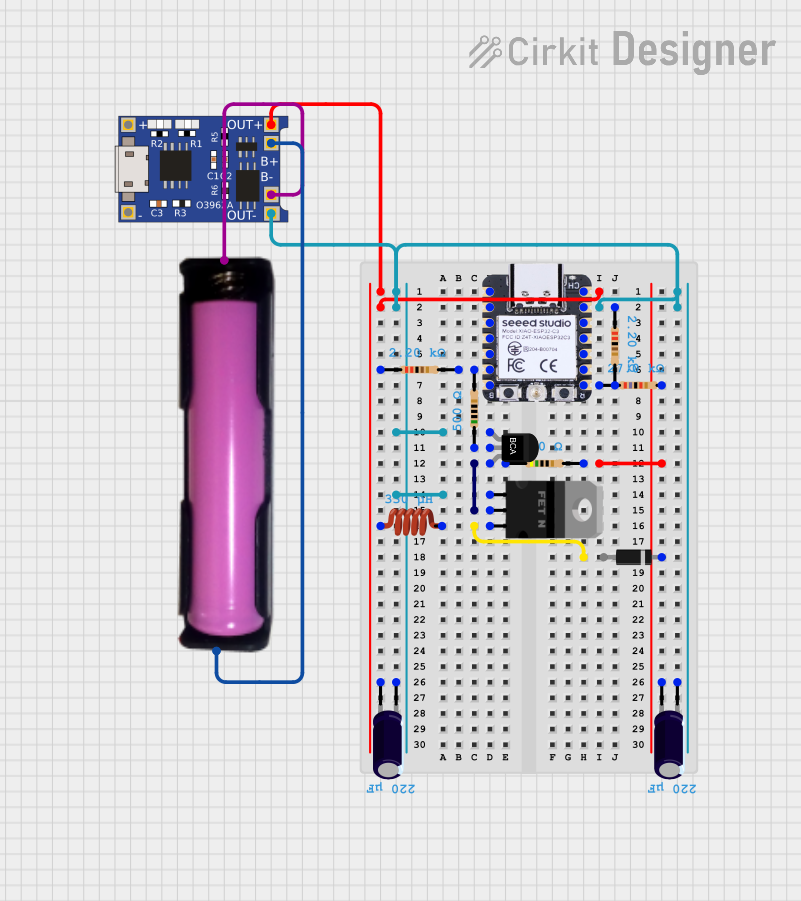
ESP32C3 Microcontroller with Battery Management and Power Regulation Circuit

Circuit Documentation
Summary
The circuit in question appears to be a power management system with a microcontroller, designed to be powered by an 18650 lithium-ion battery. The circuit includes a charging module (TP4056), power conditioning components (inductors, capacitors, diodes, and resistors), and a microcontroller (XIAO ESP32C3) for control purposes. The circuit also features transistors for switching functionalities. However, without the embedded code, the specific functions of the microcontroller cannot be detailed.
Component List
Diode
- Description: A semiconductor device that allows current to flow in one direction only.
- Purpose: Typically used for reverse voltage protection or rectification.
XIAO ESP32C3
- Description: A compact microcontroller module with Wi-Fi and Bluetooth capabilities.
- Purpose: Acts as the central processing unit for the circuit, controlling various functions and communication.
Inductor
- Description: A passive component that stores energy in a magnetic field when electric current flows through it.
- Inductance: 0.00033 Henrys
- Purpose: Used for filtering or energy storage in power supplies.
Electrolytic Capacitor
- Description: A polarized capacitor with a relatively high capacitance value.
- Capacitance: 0.00022 Farads
- Purpose: Typically used for smoothing out voltage fluctuations and as a buffer in power supplies.
Resistor
- Description: A passive two-terminal electrical component that implements electrical resistance as a circuit element.
- Resistance: Various values (500 Ohms, 2200 Ohms, 27000 Ohms, 450 Ohms)
- Purpose: Used for limiting current, dividing voltages, and other functions depending on the circuit design.
nMOS Transistor (MOSFET)
- Description: A type of field-effect transistor that has an insulated gate where the voltage determines the conductivity of the device.
- Purpose: Commonly used for switching electronic signals.
18650 in holder
- Description: A standard size rechargeable lithium-ion battery in a holder.
- Purpose: Provides the power source for the circuit.
TP4056
- Description: A complete constant-current/constant-voltage linear charger for single-cell lithium-ion batteries.
- Purpose: Used for charging the 18650 battery and providing power management.
NPN-Transistor
- Description: A type of bipolar junction transistor (BJT) where the majority charge carriers are electrons.
- Purpose: Commonly used as a switch or amplifier in circuits.
Wiring Details
Diode
- Cathode connected to the resistor (27000 Ohms).
- Anode not connected in the provided net list.
XIAO ESP32C3
- 5V connected to the inductor, electrolytic capacitor (+), and TP4056 (OUT+).
- GND connected to resistors, electrolytic capacitors (-), NPN-Transistor (E), nMOS Transistor (gate), and TP4056 (OUT-).
- GPIO7/SCL/D5 connected to resistors (500 Ohms and 2200 Ohms).
- GPIO20/Rx/D7 connected to resistors (27000 Ohms and 2200 Ohms).
Inductor
- Pin 0 connected to XIAO ESP32C3 (5V).
- Pin 1 connected to nMOS Transistor (source).
Electrolytic Capacitor
- "+" connected to XIAO ESP32C3 (5V) and resistor (27000 Ohms).
- "-" connected to XIAO ESP32C3 (GND).
Resistor
- Various resistors connected between different components as detailed in the net list.
nMOS Transistor (MOSFET)
- Gate connected to XIAO ESP32C3 (GND).
- Drain connected to NPN-Transistor (B) and resistor (450 Ohms).
- Source connected to the inductor (pin 1).
18650 in holder
- GND connected to TP4056 (B-).
- VCC connected to TP4056 (B+).
TP4056
- OUT+ connected to XIAO ESP32C3 (5V).
- OUT- connected to XIAO ESP32C3 (GND).
- B- connected to 18650 in holder (GND).
- B+ connected to 18650 in holder (VCC).
NPN-Transistor
- E connected to XIAO ESP32C3 (GND).
- C connected to resistor (500 Ohms).
- B connected to resistor (450 Ohms) and nMOS Transistor (drain).
Documented Code
No code was provided for the microcontroller or any other programmable components in the circuit. Therefore, this section cannot be completed. If code becomes available, it should be documented here with explanations of its functionality and how it interacts with the hardware components.